REQUEST COMPLIMENTARY SQLS*PLUS LICENCE
SQL SERVER – results of dynamic SQL in a variable

Is there a way to save dynamic SQL results in a variable? This is a very popular question, let’s see the answer to that question in this blog.
For example, here is dynamic SQL which we execute with sp_execute SQL. When you run a procedure, you get the results you need. In our case, we see the result line as Marketing, which is the name of the department with ID = 13.
DECLARE @sqlCommand NVARCHAR(4000)
DECLARE @ID INT
SET @ID = 13
SET @sqlCommand = 'SELECT [Name]
FROM [AndreyExWorks2018].[HumanResources].[Department]
WHERE DepartmentID = @ID'
EXEC sp_executesql @sqlCommand, N'@ID INT', @ID = @ID
Now the question arises on how to get the value of the column [Name] in a variable.
Here is a very simple trick for the same thing. Here is a script that announces an additional parameter, which is Name, and returns the value to it.
DECLARE @sqlCommand NVARCHAR(4000)
DECLARE @ID INT
DECLARE @Name NVARCHAR(100)
SET @ID = 13
SET @sqlCommand = 'SELECT @Name = [Name]
FROM [AndreyExWorks2018].[HumanResources].[Department]
WHERE DepartmentID = @ID'.
EXEC sp_executesql @sqlCommand, N'@ID INT, @Name NVARCHAR(100) OUTPUT',
@ID = @ID, @Name = @Name OUTPUT
SELECT @Name ReturnedName
You can use this script and example as a template for your need, where you want to run dynamic SQL and save the result in a variable.
If you have such a script, we ask you to share it and we will publish it with due respect. Always use sp_executesql instead of EXEC to run dynamic SQL.
MORE NEWS
PreambleNoSql is not a replacement for SQL databases but is a valid alternative for many situations where standard SQL is not the best approach for...
PreambleMongoDB Conditional operators specify a condition to which the value of the document field shall correspond.Comparison Query Operators $eq...
5 Database management trends impacting database administrationIn the realm of database management systems, moreover half (52%) of your competitors feel...
The data type is defined as the type of data that any column or variable can store in MS SQL Server. What is the data type? When you create any table or...
PreambleMS SQL Server is a client-server architecture. MS SQL Server process starts with the client application sending a query.SQL Server accepts,...
First the basics: what is the master/slave?One database server (“master”) responds and can do anything. A lot of other database servers store copies of all...
PreambleAtom Hopper (based on Apache Abdera) for those who may not know is an open-source project sponsored by Rackspace. Today we will figure out how to...
PreambleMongoDB recently introduced its new aggregation structure. This structure provides a simpler solution for calculating aggregated values rather...
FlexibilityOne of the most advertised features of MongoDB is its flexibility. Flexibility, however, is a double-edged sword. More flexibility means more...
PreambleSQLShell is a cross-platform command-line tool for SQL, similar to psql for PostgreSQL or MySQL command-line tool for MySQL.Why use it?If you...
PreambleWriting an application on top of the framework on top of the driver on top of the database is a bit like a game on the phone: you say “insert...
PreambleOracle Coherence is a distributed cache that is functionally comparable with Memcached. In addition to the basic function of the API cache, it...
PreambleIBM pureXML, a proprietary XML database built on a relational mechanism (designed for puns) that offers both relational ( SQL / XML ) and...
What is PostgreSQL array? In PostgreSQL we can define a column as an array of valid data types. The data type can be built-in, custom or enumerated....
PreambleIf you are a Linux sysadmin or developer, there comes a time when you need to manage an Oracle database that can work in your environment.In this...
PreambleStarting with Microsoft SQL Server 2008, by default, the group of local administrators is no longer added to SQL Server administrators during the...















